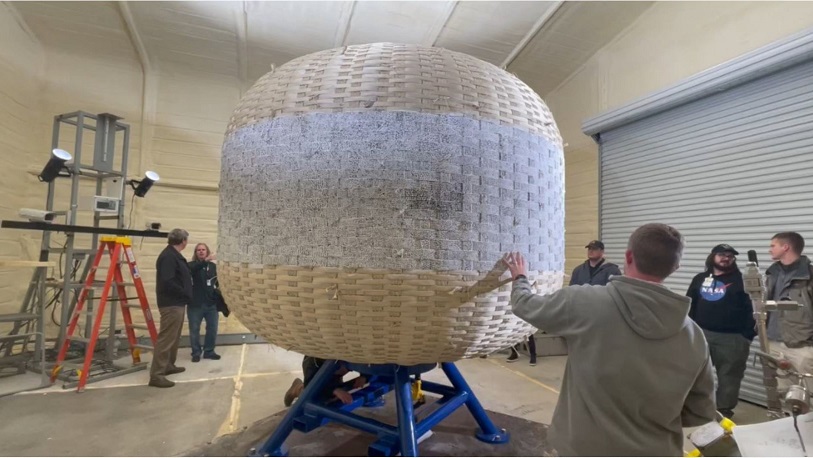Inflatable space habitation structure undergoes testing for suitability of sustaining life in extended human-rated space missions in the future
The LIFE (Large Inflatable Integrated Flexible Environment) habitat is the culmination of the latest soft goods inflatable technology development undertaken by Sierra Space, an American commercial space programme company. The objective of the equipment is to serve as an end-to-end business and technology platform to be occupied by humans in space.
LIFE is part of a line of products and Sierra Space has been working on validating its designs throughout the development efforts. Most recently, the company has been embarking on its LIFE testing campaign in combination with a group of NASA test engineers to examine the performance of the habitat. The results of the campaign so far are showing significant progress on the path to building a full-scale habitat product line with various architectures to enable human missions to low-Earth orbit, the moon and deep space.
As a result of this progress that has been made so far, the company has now also signed a new Space Act Agreement for an expanded partnership with NASA’s Marshall Space Flight Center (MSFC), which will further accelerate the development of the LIFE programme.
The LIFE platform
The LIFE structure is a key component of the company’s in-space destinations technology strategy. The inflatable module is a three-story commercial habitation, science and bio pharma platform designed to allow humans to live and work comfortably in low-Earth orbit and beyond. LIFE will serve as both the habitation and payload element for the Orbital Reef commercial space station, a collaboration between Sierra Space and Blue Origin.
Sierra Space is also undertaking development work on the commercialisation of space with the “Dream Chaser”, a commercial space-plane. In combination, both Dream Chaser and LIFE are central components to Orbital Reef, a mixed-use business park in low earth orbit being developed by principal partners Sierra Space and Blue Origin, which is expected to be operational by the end of the decade.
Successful testing
In February, Sierra Space performed a month-long Accelerated Systematic Creep (ASC) test on LIFE, which represented the first milestone in its 2023 testing campaign. The company’s test engineers loaded a one-third-scale version of the inflatable habitat with a sustained amount of pressure over an extended period of time until the structure failed. In line with NASA’s recommended guidelines for inflatable softgoods certification, the test reached its goal of generating an additional data point – the combination of the pressure and the amount of time to burst – which can be used to estimate the life of the primary pressure shell structure.
According to Sierra Space Chief Engineer for LIFE, Shawn Buckley, who is responsible for the endurance testing processes, the campaign so far this year has demonstrated that the LIFE habitat pressure shell design has a predicted life of far greater than 60 years or 525,600 hours, which is based on the specified Sierra Space 15-year on-orbit life requirement as well as the application of a safety factor of four times the specified design life.
“We are obviously simulating pressures well in excess of the norm. During tests after extreme tests, we are continuing to demonstrate that we can exceed our programme requirements, validating that LIFE’s design, manufacturing and assembly methods are consistent and repeatable,” he says.
So far, the testing has been confined to the inflatable structure itself but this isn’t enough to meet the expected use case of LIFE when deployed in space as the structure will have internal loads and components. Therefore the next step in the programme is to perform a series of one-third-scale LIFE certification tests that will focus on inserting hard structures into the pressure shell and correlating the results to previous tests. Sierra Space anticipates moving toward full-scale LIFE habitat tests later this year.
Expansion of test capabilities
Thanks to the recent Space Act Agreement that the company signed with NASA, Sierra Space is now planning to expand its collaborative environment with the Marshall Space Flight Center (MSFC), in Huntsville to continue critical work on the LIFE programme. The agreement supports ongoing design and development of LIFE test articles. To this end, a full-scale engineering mockup, which is the size of a three-story block of flats, will move to MSFC from NASA’s Kennedy Space Center. Alabama is the seventh location across the USA where Sierra Space operates facilities, joining Colorado, Florida, North Carolina, Texas, Wisconsin and Washington DC.
Sierra Space, NASA and ILC Dover (the vendor that supplies the soft goods materials) subject matter experts performed the recent set of tests inside a specially built, climate-controlled building at MSFC, adjacent to the flame trench of the Saturn 1/1B test stand where NASA tested rockets for the Apollo programme. This location is optimum for soft goods inflatable destructive testing in both performance and observation.
According to Tom Vice, the CEO of Sierra Space, NASA’s Marshall Space Flight Center has a rich history in leading highly-complex testing programmes for innovative systems and technologies in the space exploration industry.
“Under this new Space Act Agreement, we’re expanding our collaboration activities with Marshall, where we will be able to tap into that wealth of expertise, talent and facility capabilities at a much deeper level,” he says.
- UK manufacturing steps up to COVID-19 crisis - April 2, 2020
- Clustering Innovation - March 12, 2020
- A Global Monitor - March 6, 2020

